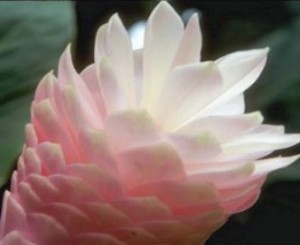Alpinia
 The genus name of Alpinia originates from Prospero Alpina, an Italian botanist who took a keen interest in exotic plants. The striking nature of this eye-catching flower means it regularly forms part of tropical flower arrangements and the leaves are also commonly used for floral decoration. Some species are even said to have medicinal properties and are used to sooth stomach complaints.
The genus name of Alpinia originates from Prospero Alpina, an Italian botanist who took a keen interest in exotic plants. The striking nature of this eye-catching flower means it regularly forms part of tropical flower arrangements and the leaves are also commonly used for floral decoration. Some species are even said to have medicinal properties and are used to sooth stomach complaints.
Description
Colours range from a distinctive red to subtle whites, yellows and pinks. Certain species of Alpinia have a shell-like appearance and either stands tall in a cone shape or bunch down depending on the exact variety.
Habitat
Favouring tropical conditions and wetland surroundings, Alpinia grow predominantly in the rainforests of Asia, although they are also commonly found in areas of Central America.
Availability
Most species bloom in mid to late-Spring and are commonly used in tropical cut flower arrangements. Make sure the ground is moist without being saturated and the soil is rich in nutrients before planting.
Species
It is from the Zingiberaceae family, which is more commonly referred to as the ginger family of flowering plants.
There are believed to be over 200 species of Alpinia and many are renowned for giving a ginger fragrance, although it is not a type of edible ginger.
Certain varieties of the Alpinia plant sometimes do not blossom for the first three years before finally flowering.
Care Tips
Ensure Alpinia bulbs are exposed to indirect light and trim regularly to ensure the plant remains at a manageable size as it can grow quickly in the correct environment. The Alpinia plant is durable, although it does require plenty of water and proper drainage.
Did you know?
The Alpinia plant can reach heights of up to 15-feet tall in its natural environment, although it’s much more common to grow to a height of just over a third of that.
The optimum temperature for Alpinia flowers to prosper is thought to be anything in excess of 15 degrees Celsius.
Alpinia leaf extract is used to treat high blood pressure in countries like Brazil and is also taken to cure indigestion and stomach problems.


